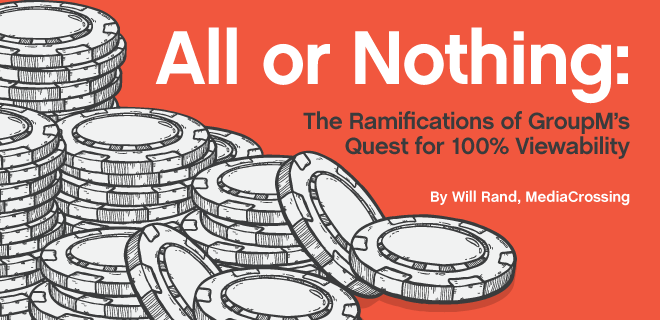
For years, GroupM honchos have said that ads not seen by human beings should not be paid for. Now media agency is making good on that promise – in addition to numerous US publishers billing off a 100% viewable impression standard, AdNews Australia reports that nine Australian publishers have cut similar deals with GroupM.
The IAB and MRC have argued that billing on 100% viewability is not feasible with current technological limitations – unfortunately, not every impression served on a publisher’s site can be measured, regardless of methodology. Even the sites with inventory that’s most highly in-view (which are generally e-mail sites such as outlook.com or mail.aol.com) have around a 90% rate. That means those extra 10% of impressions that aren’t measured will be considered a value-add and not paid for.
There still isn’t a totally agreed upon methodology of viewability measurement. Most of the verification companies (IAS, Moat, Pixalate, etc.) still measure viewability in different ways, which theoretically gives them each a competitive advantage. It appears that GroupM will go off Moat’s numbers. A major roadblock to switching to an industry-wide viewable impression payment standard is that there are so many ways to measure viewability. That still needs to shake out.
For those on the buy side, the 100% campaign viewability will slowly become the new standard. For many advertisers, and likely the biggest brands, total ad viewability will not be recommended, it will be required. Ads not seen by users will be worth nothing and will not be paid for. This goes for both direct response and branding campaigns. For branding, why should an advertiser pay for an ad that isn’t seen by a user, particularly buys that are supposed to “drive awareness?” It makes no sense.
View-through conversions, already under-fire from skeptics who wonder how many of those people were going to convert regardless of media spend, will be devalued further. If your view-through conversions weren’t rated as being seen, they will be ignored by smart media buyers. And with many sites stuck at viewability rates of 40%-50%, we’re talking about half of view-through conversions going “bye-bye.” Buy-siders, enjoy explaining that to your clients.
However, GroupM has the financial clout and juice to get away with ducking out on paying publishers for unseen ads, but other advertisers might not. That means that either payment terms with publishers or DSPs have to change to a viewable impression standard (which will be difficult for all involved). Otherwise, advertisers will have to run a lot of make-good impressions. If you’ve booked 1 million viewable impressions, and the standard viewability rate is 50% on the media that you run on, you’ll have to serve 2 million actual impressions to hit that booked 1 million viewable.
Another possibility is that the major DSPs will only pay their supply partners for ads that are considered in-view, but this a long way off.
Regardless, it’ll be harder for operations people to manage campaigns. Campaign impression/spend goals will have to be adjusted based on viewability rates, which aren’t exactly known until after the media is run. Fun times!
Sell Side Woes
For publishers, if ad viewability wasn’t a concern for you before, it will be now. If your ads are not measurable or not in-view, eventually they will not be paid for by anyone (though that might take a long time). If you’re an ad-based business, your business will vaporize.
Your only chance of survival is to make sure that your ads are as measurable and in-view as possible. That means signing on with a partner, testing and improving. AdSense and many other demand sources provide viewability metrics, which will do in a pinch. Mobile viewability is also coming soon and I expect that the same standard will be applied there as well.
In the short term, publishers with high rates of viewability will get paid very well as the demand for their inventory will jump even more than it already has. Many DSPs have functionality which makes it easy to buy highly in-view impressions, and that kind of buying will additionally raise CPMs for publishers. With all that in mind, buyers aren’t stupid. If they see one site that’s near 100% in-view for $5 CPM, and another that’s 50% in-view for a $2 CPM, they’ll go with the second option and just buy double the number of impressions.
Either way, by doing the right thing by their advertisers and making sure that ads are visible and easily seen, publishers will be rewarded. Imagine that!
Ultimately, 100% viewability is a great thing for GroupM and their clients, as well as the industry on the whole. GroupM clients will regard their media agency as a good steward for their ad dollars and be more likely to stay with them because of it – which is important in the era of Reviewapalooza. And GroupM can (rightly) say that it, more than anyone else, has pushed the industry in a direction towards more viewable, non-fraudulent impressions. That’s a hell of a thing to put on a pitch deck.